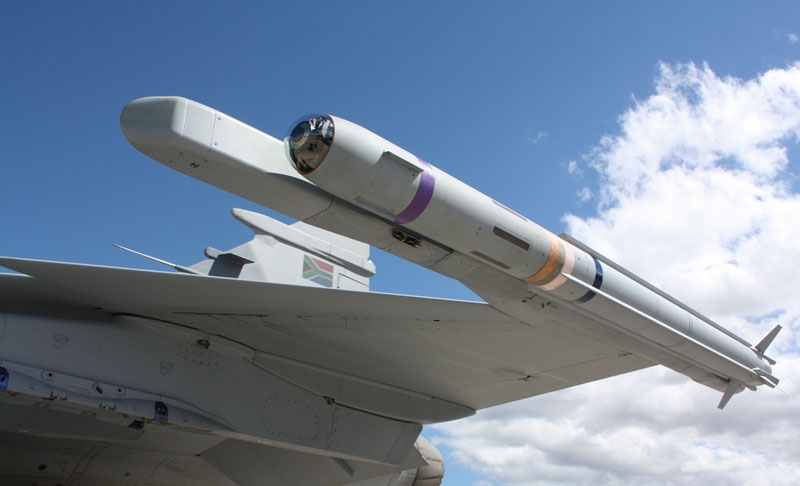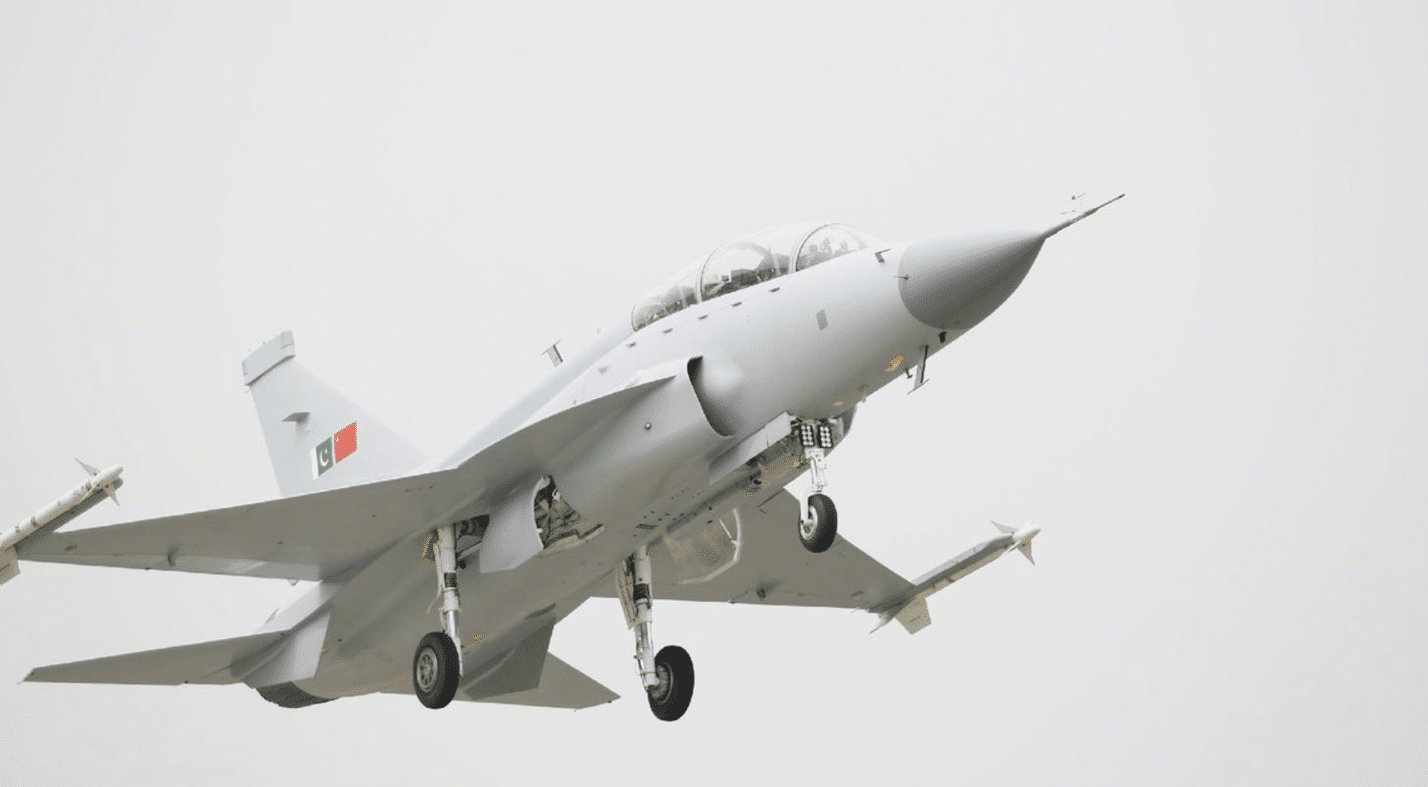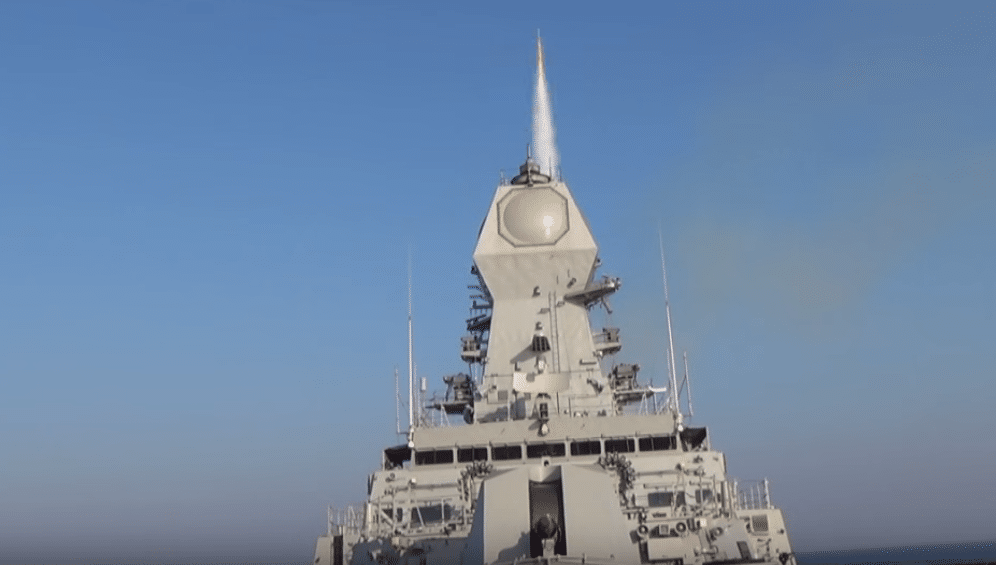1760Views 13Comments

Denel provides updates on A-Darter and Marlin programs
In its financial report for 2016-2017, Denel Group has outlined its progress in preparing the A-Darter high-off-boresight (HOBS) air-to-air missile (AAM) for serial production as well as its efforts to develop a next-generation beyond visual-range (BVR) AAM under the Marlin program.
In terms of the A-Darter HOBS AAM, Denel states, “[the] missile’s seeker performance qualification flight trials were successfully completed. Its critical design review was completed, thus finalising the design baseline for industrialisation and manufacturing.”
Denel expects to complete the final qualification tests of the A-Darter in 2017. Denel prices the program value of the A-Darter at ZAR 2 billion (i.e. $149.3 million U.S. in 2017). The South African Air Force (SAAF) placed a ZAR 939 million order in 2015. Denel plans to deliver training missiles to the SAAF in late 2017, and the final set of operational A-Darter missiles in Q1 2020. The A-Darter benefits from a thrust-vectoring nozzle for tight maneuvering and an imaging infrared (IIR) seeker for jam-resistant target tracking. It can also be paired with a helmet-mounted display and sight (HMD/S) system for target cuing.
Regarding the Marlin, Denel Dynamics had successfully conducted a test launch at Denel’s Overberg Test Range (OTR) in July 2016. Denel states, “The main objective of the test was to prove safe launch of the missile from an aircraft platform, which also showed the missile airframe was stable. This test laid the foundation for captive and guided flight tests and for further technology development of the missile.”
Denel revealed the Marlin in 2014 as a comprehensive platform that can be employed as a BVRAAM and as a medium-range surface-to-air missile (SAM). If brought to fruition, the final solution would be powered by a dual-pulse rocket motor and utilize a terminal-stage active radar-homing (ARH) seeker. As a BVRAAM, the Marlin would have a range of 100 km. The range of the SAM is not known, but Denel’s extended range or long-range Umkhonto proposal (Umkhonto ER/LR) was to have a range of 60 km.
To firmly secure the development of the Marlin, Denel Dynamics is seeking a partner to share funding, to support development and guarantee launch orders. The A-Darter is a joint-venture between Denel Group and Brazil’s Avibrás, Mectron and Opto Eletrônica. Brazil issued its A-Darter order in November 2016.
Denel also disclosed two new munitions. First, the company outlined that it undertook flight tests for a “medium range, low-cost guided weapon” for an undisclosed client in early 2017. Denel says, “the weapons released hitting the target within set specifications and the client expressing satisfaction with the weapon’s performance.” Second, Denel Dynamics tested a “long-range IIR [imaging infrared] guided weapon” with results showing “exceptional accuracy.”
Notes & Comments:
Denel did not provide a progress update to the Umkhonto EIR, which was to be a longer-range update to the Umkhonto-series of SAM. The Umkhonto EIR was slated to have a range of 30-35 km, while still using a terminal-stage infrared (IR) seeker. It is likely that the Umkhonto EIR, like many Denel programs, requires an overseas partner to complete development. While unideal, it should be noted that the South African Rand (ZAR) offers the advantage of lower foreign currency outflows for prospective partners, especially in developing world markets, which are Denel’s principal markets. Denel is also amenable to offsets and countertrade measures, which can help limit currency outflow and stimulate client economies.
In terms of prospective clients, Denel Group has identified 10 key target markets: Algeria, Brazil, Kenya, Malaysia, Mozambique, Oman, Pakistan, South Africa, Turkey and the United Arab Emirates (UAE). Algeria and the UAE have been Denel’s leading markets in recent years, especially the UAE as it has acquired the Tariq precision-guided bomb (PGB) kit and N35 mine-resistant ambush-protected (MRAP) vehicles from Denel Dynamics and Denel Land Systems, respectively.
Denel listing Pakistan echoes the bilateral defence agreement South Africa and Pakistan signed in March. In 2016, Denel Land Systems had demonstrated the T5-52 155 mm/52-calibre self-propelled howitzer in Pakistan, which Denel says were “successful.” The state of Pakistan’s howitzer plans is not known, but in 2016, IHS Jane’s projected that Pakistan could spend $844 million U.S. on howitzers from 2016-2024. In addition, Denel could also look at Pakistan’s light armoured vehicle (and MRAP), aircraft development and manufacturing, and armour/tank programs as prospective market opportunities.
The A-Darter HOBS AAM has also been viewed as a prospective business area. In 2015, the Pakistan Air Force (PAF) had listed the A-Darter as a HOBS AAM option for the forthcoming JF-17 Block-III[1], which the PAF expects will enter production in 2019 or 2020. With the PAF intent on localizing the supply of its air warfare solutions, most notably current and next-generation combat aircraft, Denel Group could consider pitching a comprehensive air-to-air and air-to-surface munitions development suite for the PAF with co-development and co-production mechanisms. Interestingly, Denel had offered something in this vein to the PAF for the then Super-7 (i.e. JF-17) in 1999. The package included ramjet-powered AAM designs.
[1] Alan Warnes. “JF-17 Thunder: Pakistan’s multi-role fighter.” Note: a special publication released by the Pakistan Air Force during the Paris Air Show of 2015.



13 Comments
by 16631
Dear Bilal, I am a regular reader of your articles specialy JF 17 and our air force specially. Here I am sharing a link for other readers. http://www.thedrive.com/the-war-zone/15233/greece-plans-to-spend-billions-upgrading-its-f-16-fighter-jet-fleet. May be you can shed some light on fate of our F 16 fleet. Although we all now the strings and constraints attached to it unfortunately.
by TZK
Several questions spring to mind, will USA approve such an upgrade for PAF, will India object, can Pak afford it, will USA advance credit, will the upgraded F16’s match the Indian Rafale. At $20M per upgrade will cost about $1.5B for the PAF fleet which is equivalent to about 30-40 4.5 gen off the shelf jets.
by Bilal Khan
It doesn’t seem that U.S.-Pakistani defence ties are at a point right now where upgrading the F-16s is tenable. According to Pakistan’s FM Khawaja Asif the U.S. even stopped Jordan from selling used F-16s to Pakistan.
by TZK
Lockheed and Boeing offering India F16 and F18 along with production. Pak F16’s are probably the biggest obstacle for them, so more F16’s or upgrade kits probably out of the question. I suspect that India will choose the Saab Gripen who have also offered to build it locally. If India rejects US planes they may change their minds about Pak!
by Faisal
under present circumstances it will be very difficult for any US administration justify any F-16 related sale to Pakistan. They have created so much media hype about Pakistan that everybody over there has developed a stereotype about Pakistan. Very hard to take a turn and say it was all false and they qualify for F-16s now. In a way its a big positive for Pakistan. They should have taken an independent route long time ago but US has been throwing smaller offerings to kill all those programs.
by Bilal Khan
Some analysts are saying that India won’t sign a deal for single engine jets until 2019. Moreover, the IAF is apparently showing its reluctance towards signing onto the FGFA.
These two factors might set the road for the IAF to seriously consider the F-35, which would also fit well with long-term U.S. industry interests (India would offer a lot of scale) and fit with the IAF’s long-term requirements on several fronts.
The single-engine fighter bid is an odd-ball seeing that India does have the Tejas Mk2 in development, which is pretty close in scope to the Gripen E/F (one of the competitors for the single-engine bid).
Combining the single engine and 5th-gen fighter bid would be helpful for them in that (1) it’ll guarantee the Tejas Mk2’s value and (2) begin early talks for the F-35 with the U.S. Gov’t and LM. This would help the U.S. by (1) bolstering the long-term project (i.e. F-35) and (2) support U.S. security interests by giving India a credible means to address China’s qualitative jumps.
by Joseph
I think the only reason India hasn’t bought F-35 already (other than how expensive F-35s are) is because from what I hear only the early participants of JSF program get technology transfers depending on how much money they invested in the development, everyone else can only buy the planes.
That shows India insisted on acquiring stealth technology, and Russia was really the only credible partner capable enough and maybe willing to share.
But if FGFA fell through, it might force India to buy F-35s.
by Bilal Khan
They might be limited in terms of the F-35, but as a Major Defence Partner, I’m sure they can access some 5th-gen relevant technology from LM et. al (like South Korea for the KFX). Buying into the F-35 in the present could help open that stuff up over the long-term for another (i.e. Indian) fighter program.
by Joseph
That is true. South Korea was able to leverage F-35 purchase to secure some of the technology transfers for KFX, India might be able to do the same for their AMCA project.
South Korea seems unable to obtain several key technologies from US including AESA radar and IRST, etc.
But if FGFA falls apart, that is probably the most viable (maybe the only) way to get AMCA off ground. I think we all know it is unlikely for India to complete AMCA on it’s own.
by TZK
It appears that the navy and air force are in favour of F35 but geopolitically India does not want to burn bridges with Russia. The article in this link seems to cast doubt on the Tejas but it could all be a smokescreen.
http://carnegieendowment.org/2017/08/02/americans-are-back-f-16-for-iaf-and-f-18-for-indian-navy-pub-72706
by Joseph
The guy works for Tata and Tata already has a joint venture with Lockheed Martin so if India air force and navy both choose American fighters I think that would mean more works for his company, so his subtle lobby for US is understandable.
But he is an industry insider (maybe the ultimate insider in terms of Indian defense industry), so what he said about Tejas is likely true. When an Indian speaks ill of indigenous efforts he better has facts backing it up. Also the fact both IAF and IN looking overseas for a light/medium multi-role fighter, which is preciously what Tejas is supposed to be, is not really a vote of confidence for Tejas or it’s next version. (Let’s use Tejas to bomb some insurgents who only have rifles, but we still need some real fighters for real enemies)
The surprise is neither IAF nor IN considered F-35. IAF I can understand is waiting for FGFA. Why is IN not considering F-35? F-35 is single engine for sure but it is good enough for US and UK carriers, why is it not good enough for Indian carriers? Do they know something about F-35 we don’t know? Something like your guys already put in deposit for F-35 and it is too late to cancel, like what we did with Tejas, but don’t try to sell us your problems kind of thing, maybe?
by TZK
He also said:
Because combat aviation is steadily moving towards the dominance of stealthy platforms, India should be seeking to leverage these purchases towards the development or the acquisition of fifth-generation fighters.
by Joseph
That could imply US has yet to grant India permission to buy F-35 (at least this guy seems to be in favor of F-35), or FGFA is still in the picture India still has not made up it’s mind about the future of it’s stealth platform. Or maybe choosing F-35 would mean dropping the indigenous AMCA project.
We probably have to wait for the result of FGFA to certain and it seems we won’t have to wait for long: https://www.defensenews.com/air/2017/10/20/indian-air-force-wants-out-of-fighter-program-with-russia/